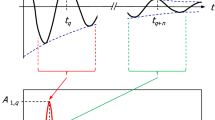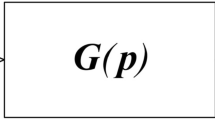Abstract
Linear cyclic systems (LCS’s) are a class of systems whose dynamic behavior changes cyclically. Such cyclic behavior is ubiquitous in systems with fundamentally repetitive motions (e. g. all rotating machinery). Yet, the knowledge of the noise and vibration transmission paths in LCS’s is quite limited due to the time-varying nature of their dynamics. The first part of this two-part paper derives a generic expression that describes how the noise and/or vibration are transmitted between two (or multiple) locations in the LCS’s. An analysis via the Fourier series and Fourier transform (FT) plays a major role in deriving this expression that turns out to be transfer function dependent upon the cycle position of the system. The cyclic nature of the LCS’ transfer functions is shown to generate a series of amplitude modulated input signals whose carrier frequencies are harmonic multiples of the LCS’ fundamental frequency. Applicability of signal processing techniques used in the linear time-invariant systems (LTIS’s to the general LCSs is also discussed. Then, a criterion is proposed to determine how well a LCS can be approximated as a LTIS. In Part II, experimental validation of the analyses carried out in Part I is provided.
Similar content being viewed by others
References
Barker, R. W. and Hinich, M. J., 1994, “Statistical Monitoring of Rotation Machinery by Cumulant Spectral Analysis,” inProc. of the SPIE, San Diego, CA, USA, Vol. 2296, pp. 43–51.
Belousov, Y. I. and Rimskii-Korsakov, A. V., 1975, “The Reciprocity Principle in Acoustics and its Application to the Calculation of Sound Fields of Bodies,”Sov. Phys. Acoustics., Vol. 21, No. 2, pp. 103–109.
Bracewell, R. N., 1986,The Fourier Transform and Its Applications, McGraw-Hill, New York, Second edition, revised.
Cann, R. G., 1992, “New Diagnostic Procedures for Locating Faults in Diesel Engines,”Diesel and Gas Turbine Worldwide, Vol. 24, No. 6, pp. 52–55.
Ha, H. T. R., 1995, “Vibration Control of Rotor,”KSME, Vol. 35, No. 10, pp. 917–923 1225–5955.
Harrap, M. J. and Wang, W. Y., 1994, “Vibration Analysis Techniques Used in Machinery Fault Derdction,”Acoustics Australia, Vol. 22, No. 3, pp. 91–95.
Kailath, T., 1980,Linear Systems, Prentice Hall, Englewood Cliffs, NJ.
Kinsler, L. F., Frey, A. R., Coppens, A. B. and Sanders, J. V., 1982,Fundamentals of Acoustics, John Wiley & Sons, 3rd edtion.
Lou, K. N., Sherman, P. J. and Lyon, D. F., 1993, “System Identification and Coherence Analysis in the Presense of s Harmonic Signal,”Mechanical Systems and Signal Processing, Vol. 7, No. 1, pp. 13–27.
Meng, Qingfeng and Qu, Liangsheng, 1991, “Rotating Machinery Fault Diagnosis Using Wigner Distribution,”Mechanical Systems and Signal Processing, Vol. 5, No. 3, pp. 155–166.
Mohamed, A. M. and Busch-Vishniac, I., 1995, “Imbalance Compensation and Automation Balancing in Magnetic Bearing Systems Using the q-Paramerization Theory,”IEEE Trans. On Control Systems Technology, Vol. 3, No. 2, pp. 202–211.
Oh, J. Y., 1993, “The Active Noise Control in Harmonic Enclosed Sound Fields (I): Computer Simulation,”KSME, Vol. 17, No. 5, pp. 1054–1065 1225–5963.
Rantala, S. and Suoranta, R., 1991, “Enhanced Vibration Monitoring Using Parametric Modeling Technique,” inProc. of IEEE Intrumentaion and Measurement Technology Conference, Atlanta, GA, USA.
Tamaki, K., Matsuoka, Y., Uno, M. and Kawana, T., 1995, “Wavelet Transform Based Signal Waveform Discrimination for Inspection of Rotating Machinery,”Transactions of the Institute of Electrical Engineers of Japan, Part D, No. 6, pp. 755–783.
Ten Wolde, T., 1973,Reciprocity Experiments on the Transmission of Sound in Ships, PhD thesis, Delft University.
Ten Wolde, T., 1976, “Reciprocity Measurement of Acoustical Source Strength in an Arbitrary Surrounding,”Noise Control Engineering, pp. 16–23.
Young, D. L., 1994, “Source Identification and Advanced Signal Processing Methods: User’s Guide,” Tech. Rep. UTRC 94-37, Advanced Compressor Technology, United Technology Research Center, E. Hartford, CT.
Author information
Authors and Affiliations
Corresponding author
Rights and permissions
About this article
Cite this article
Kim, H.J., Cho, Y.M. Dynamic characterization of noise and vibration transmission paths in linear cyclic systems (I). KSME International Journal 14, 1051–1060 (2000). https://doi.org/10.1007/BF03185059
Received:
Revised:
Issue Date:
DOI: https://doi.org/10.1007/BF03185059




